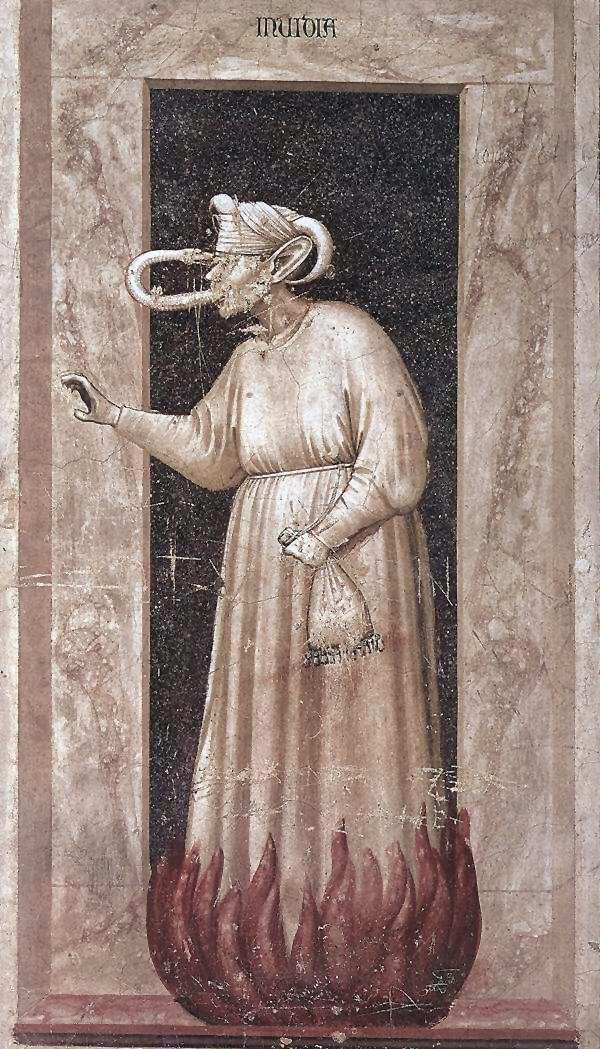Giotto and A la recherche du temps perdu

Envy, from Giotto’s Arena Chapel frescoes
To paint pictures is to live in a state of paradox. What I intend usually just points me in the direction of what I achieve, and by not achieving quite what I want, I sometimes succeed in ways I wouldn’t have imagined and may not even realize. Occasionally I invest paint with something far better than what I could have intended or predicted. In every success, there’s a bit of surprise, if not discovery.
When you begin to realize how great paintings aren’t necessarily limited by whatever outcomes the painter desired, it dawns on you that this is how life itself works, almost invariably. All of your representations, all of your mental pictures of what matters in life fail to embody what it is you think those images represent. Try to picture anything—goodness for example—and whatever instance of goodness you imagine will fail to capture what it actually is. And, even if you lower your sights and accept the consolation prize of depicting what’s actually visible in life, even then, there’s shortfall. What you do picture to yourself as familiarly good will rarely resemble how living, new instances of goodness actually appear.
Early in Swann’s Way, Marcel Proust elaborates on a physical similarity between his cook’s pregnant kitchen-maid and one of Giotto’s figures of virtue and vice in his Paduan frescoes. It’s a little running joke between the novel’s protagonist and Swann, when he comes to visit and asks how things are going with Giotto’s Charity. As his focus shifts from the kitchen-maid to the painter, the way Proust elaborates on the Gothic painter, circling around his subject, reminds me of how Francis Bacon, in his essay on it, seems to turn the subject of Truth inside-out and then outside-in, until you are almost completely disoriented but left with a kind of Socratic doubt about your own callow assumption that you can actually know Truth. In the same way, you think you’ve understood Proust’s point and suddenly he seems to be saying just the opposite—this symbolizes X, but X is nowhere visible in the behavior depicted and yet the reality of X is embodied by it. Come again? It does make sense, but at first it feels like riding in circles on a Mobius strip. All the while he asks you to keep reconsidering what exactly is happening in Giotto’s paintings of virtue and vice—forcing you to go back and look at them. Which is both the first and last step in letting a painting do its work.
For years, I’ve considered Proust a purposely amoral novelist, someone so driven to see exactly what’s happening in human behavior and human consciousness, that he can’t stop to pass judgement on the behavior he depicts—not letting discriminations of good and evil constrain his phenomenology. Passing judgment on something gives you an excuse to ignore what you’re seeing. I’m beginning to think differently. In my third reading of this novel right now (first in college, second when the Kilmartin translation was published), I’ve delved only a hundred pages into the book, and it seems he was constantly thinking of goodness, interested in why his many of his characters found it so difficult to see and embody it. His ability to convey goodness was so fresh, so unsentimental, that it’s hard to realize what he’s doing as it happens on the page—in a way analogous to his consistent depiction of social and sexual relationships as detours that usually lead away from an authentic life. In a way similar to how I’m seeing this new dimension in Proust, this year I’ve become more and more interested in visual art that seems to be doing exactly the opposite of what I think painting and drawing should do when operating in its most innate way. Painting that has always struck me as the most fully realized has no meaning. Any effort to extract meaning from it is, in a way, to look away from what’s actually happening in the work, the awareness it can generate, and nullify it by translating it into thought. (In the same way, the best passages of Bergotte’s writing have an impact on Proust’s narrator unrelated to their significance. In one of his book’s quietly amusing moments, Bloch advises him to read only poetry that means nothing.) What’s most powerful in a work of visual art has nothing to do with meaning: deconstructing it will get you places, but it won’t replace the looking and often gets in the way. MORE